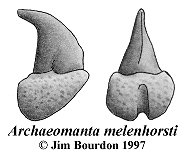| |
Known only from isolated teeth, this genus was erected to accommodate fossil teeth similar
in design (outwardly at least) to the extant species Manta birostris. These teeth have
been reported from Upper Paleocene through Middle Eocene sediments of Europe, Africa
and North America. If attention is given to smaller teeth, those from this genus appear to be
abundant when present.
These teeth are easily recognized by their peg-like design and bulbous root. Unlike the living
manta ray, the crown rises directly from the root, bears a median ridge and is fully covered with
enameloid. Two species have been assigned to the genus, Archaeomanta priemi HERMAN
1979 which appears to be relegated to the Upper Paleocene of Morocco, and the more
widely distributed Eocene species, A. melenhorsti HERMAN 1979.
Noubhani & Cappetta (1997) note an undescribed Archaeomanta species from the Danian
(Lower Paleocene) of Morocco.
 |
Fig. 1
Archaeomanta melenhorsti
hgt = 3.0, wid = 1.0, dep = 1.8 mm
Nanjemoy Formation, Virginia |
Specific References
Herman, J., 1979. Additions to the Eocene fish fauna of Belgium. 4. Archaeomanta,
a new genus from the Belgian and North African Palaeogene. Tertiary Res., 2 (2), p. 61-67.
|